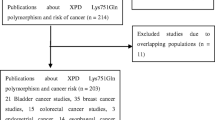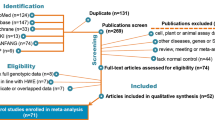Abstract
Studies on polymorphisms of Xeroderma Pigmentosum Group D Protein (XPD) and breast cancer risk are inconclusive. To elucidate the role of XPD genotypes, all available studies were considered in this meta-analysis. The study provided 11,362/10,622 cases/controls for XPD K751Q and 9010/9873 cases/controls for XPD D312N, respectively. Overall, no apparent effects of 751Q allele compared to 751K on breast cancer risk was found in all subjects [RE OR = 1.04, 95% confidence interval (CI) (0.97–1.10), P = 0.28]. Insignificant effects were also found under other genetic contrasts (homologous contrast, dominant model, and recessive model). However, the 751Q allele showed significantly increased risk in Caucasians [FE OR = 1.05, 95% CI (1.00–1.11), P = 0.035]. In addition, insignificant risk effects of D312N polymorphism on breast cancer susceptibility were observed in all subjects under any genetic contrast, but protective effects of 312NN genotype were observed under recessive model [P = 0.02, OR = 0.53, 95% CI (0.32, 0.90)] and homozygote contrast [P = 0.03, OR = 0.55; 95% CI (0.32, 0.96)] in Asians. In summary, our meta-analysis suggested 312N allele might act as a recessive allele in its association with breast cancer and the 751Q allele may play a plausible role in breast cancer development whereas the ethnic background should be carefully concerned in further studies.




Similar content being viewed by others
References
Jemal A, Siegel R, Ward E, Murray T, Xu J, Thun MJ (2007) Cancer statistics, 2007. CA Cancer J Clin 57:43–66. doi:10.3322/canjclin.57.1.43
Cairns J (1982) Aging and cancer as genetic phenomena. Natl Cancer Inst Monogr 60:237–239
Knudson AG Jr (1989) The genetic predisposition to cancer. Birth Defects Orig Artic Ser 25:15–27
Shields PG, Harris CC (1991) Molecular epidemiology and the genetics of environmental cancer. JAMA 266:681–687. doi:10.1001/jama.266.5.681
Squire JA, Whitmore GF, Phillips RA (1998) The basic science of oncology. McGraw-Hill, New York
Friedberg EC (2001) How nucleotide excision repair protects against cancer. Nat Rev Cancer 1:22–33. doi:10.1038/35094000
Tang D, Cho S, Rundle A, Chen S, Phillips D, Zhou J, Hsu Y, Schnabel F, Estabrook A, Perera FP (2002) Polymorphisms in the DNA repair enzyme XPD are associated with increased levels of PAH–DNA adducts in a case–control study of breast cancer. Breast Cancer Res Treat 75:159–166. doi:10.1023/A:1019693504183
Synowiec E, Stefanska J, Morawiec Z, Blasiak J, Wozniak K (2008) Association between DNA damage, DNA repair genes variability and clinical characteristics in breast cancer patients. Mutat Res 648:65–72. doi:10.1016/j.mrfmmm.2008.09.014
Li J, Jin W, Chen Y, Di G, Wu J, Shao ZM (2008) Genetic polymorphisms in the DNA repair enzyme ERCC2 and breast tumour risk in a Chinese population. J Int Med Res 36:479–488
Justenhoven C, Hamann U, Pesch B, Harth V, Rabstein S, Baisch C, Vollmert C, Illig T, Ko YD, Brüning T, Brauch H (2004) ERCC2 genotypes and a corresponding haplotype are linked with breast cancer risk in a German population. Cancer Epidemiol Biomarkers Prev 13:2059–2064
Shi Q, Wang LE, Bondy ML, Brewster A, Singletary SE, Wei Q (2004) Reduced DNA repair of benzo[a]pyrene diol epoxide-induced adducts and common XPD polymorphisms in breast cancer patients. Carcinogenesis 25:1695–1700. doi:10.1093/carcin/bgh167
Terry MB, Gammon MD, Zhang FF, Eng SM, Sagiv SK, Paykin AB, Wang Q, Hayes S, Teitelbaum SL, Neugut AI, Santella RM (2004) Polymorphism in the DNA repair gene XPD, polycyclic aromatic hydrocarbon-DNA adducts, cigarette smoking, and breast cancer risk. Cancer Epidemiol Biomarkers Prev 13:2053–2058
Dufloth RM, Costa S, Schmitt F, Zeferino LC (2005) DNA repair gene polymorphisms and susceptibility to familial breast cancer in a group of patients from Campinas, Brazil. Genet Mol Res 4:771–782
Lee SA, Lee KM, Park WY, Kim B, Nam J, Yoo KY, Noh DY, Ahn SH, Hirvonen A, Kang D (2005) Obesity and genetic polymorphism of ERCC2 and ERCC4 as modifiers of risk of breast cancer. Exp Mol Med 37:86–90
Kuschel B, Chenevix-Trench G, Spurdle AB, Chen X, Hopper JL, Giles GG, McCredie M, Chang-Claude J, Gregory CS, Day NE, Easton DF, Ponder BA, Dunning AM, Pharoah PD (2005) Common polymorphisms in ERCC2 (Xeroderma pigmentosum D) are not associated with breast cancer risk. Cancer Epidemiol Biomarkers Prev 14:1828–1831. doi:10.1158/1055-9965.EPI-04-0807
Metsola K, Kataja V, Sillanpää P, Siivola P, Heikinheimo L, Eskelinen M, Kosma VM, Uusitupa M, Hirvonen A (2005) XRCC1 and XPD genetic polymorphisms, smoking and breast cancer risk in a Finnish case–control study. Breast Cancer Res 7:987–997. doi:10.1186/bcr1333
Zhang L, Zhang Z, Yan W (2005) Single nucleotide polymorphisms for DNA repair genes in breast cancer patients. Clin Chim Acta 359:150–155. doi:10.1016/j.cccn.2005.03.047
Brewster AM, Jorgensen TJ, Ruczinski I, Huang HY, Hoffman S, Thuita L, Newschaffer C, Lunn RM, Bell D, Helzlsouer KJ (2006) Polymorphisms of the DNA repair genes XPD (Lys751Gln) and XRCC1 (Arg399Gln and Arg194Trp): relationship to breast cancer risk and familial predisposition to breast cancer. Breast Cancer Res Treat 95:73–80. doi:10.1007/s10549-005-9045-3
Debniak T, Scott RJ, Huzarski T, Byrski T, Masojć B, van de Wetering T, Serrano-Fernandez P, Górski B, Cybulski C, Gronwald J, Debniak B, Maleszka R, Kładny J, Bieniek A, Nagay L, Haus O, Grzybowska E, Wandzel P, Niepsuj S, Narod SA, Lubinski J (2006) XPD common variants and their association with melanoma and breast cancer risk. Breast Cancer Res Treat 98:209–215. doi:10.1007/s10549-005-9151-2
Mechanic LE, Millikan RC, Player J, de Cotret AR, Winkel S, Worley K, Heard K, Heard K, Tse CK, Keku T (2006) Polymorphisms in nucleotide excision repair genes, smoking and breast cancer in African Americans and whites: a population-based case–control study. Carcinogenesis 27:1377–1385. doi:10.1093/carcin/bgi330
Onay VU, Briollais L, Knight JA, Shi E, Wang Y, Wells S, Li H, Rajendram I, Andrulis IL, Ozcelik H (2006) SNP-SNP interactions in breast cancer susceptibility. BMC Cancer 6:114. doi:10.1186/1471-2407-6-114
Shen J, Desai M, Agrawal M, Kennedy DO, Senie RT, Santella RM, Terry MB (2006) Polymorphisms in nucleotide excision repair genes and DNA repair capacity phenotype in sisters discordant for breast cancer. Cancer Epidemiol Biomarkers Prev 15:1614–1619. doi:10.1158/1055-9965.EPI-06-0218
Crew KD, Gammon MD, Terry MB, Zhang FF, Zablotska LB, Agrawal M, Shen J, Long CM, Eng SM, Sagiv SK, Teitelbaum SL, Neugut AI, Santella RM (2007) Polymorphisms in nucleotide excision repair genes, polycyclic aromatic hydrocarbon-DNA adducts, and breast cancer risk. Cancer Epidemiol Biomarkers Prev 16:2033–2041. doi:10.1158/1055-9965.EPI-07-0096
Costa S, Pinto D, Pereira D, Rodrigues H, Cameselle-Teijeiro J, Medeiros R, Schmitt F (2007) DNA repair polymorphisms might contribute differentially on familial and sporadic breast cancer susceptibility: a study on a Portuguese population. Breast Cancer Res Treat 103:209–217. doi:10.1007/s10549-006-9364-z
Jorgensen TJ, Visvanathan K, Ruczinski I, Thuita L, Hoffman S, Helzlsouer KJ (2007) Breast cancer risk is not associated with polymorphic forms of xeroderma pigmentosum genes in a cohort of women from Washington County, Maryland. Breast Cancer Res Treat 101:65–71. doi:10.1007/s10549-006-9263-3
Rajaraman P, Bhatti P, Doody MM, Simon SL, Weinstock RM, Linet MS, Rosenstein M, Stovall M, Alexander BH, Preston DL, Sigurdson AJ (2008) Nucleotide excision repair polymorphisms may modify ionizing radiation-related breast cancer risk in US radiologic technologists. Int J Cancer 123:2713–2716. doi:10.1002/ijc.23779
Shore RE, Zeleniuch-Jacquotte A, Currie D, Mohrenweiser H, Afanasyeva Y, Koenig KL, Arslan AA, Toniolo P, Wirgin I (2008) Polymorphisms in XPC and ERCC2 genes, smoking and breast cancer risk. Int J Cancer 122:2101–2105. doi:10.1002/ijc.23361
Woolf B (1955) On estimating the relation between blood group and disease. Ann Hum Genet 19:251–253. doi:10.1111/j.1469-1809.1955.tb01348.x
Lau J, Ioannidis JP, Schmid CH (1997) Quantitative synthesis in systematicreviews. Ann Intern Med 127:820–826
Higgins JPT, Thompson SG, Deek JJ, Altman DG (2003) Measuring inconsistency in meta-analyses. BMJ 327:557–560. doi:10.1136/bmj.327.7414.557
Egger M, Davey SG, Schneider M, Minder C (1997) Bias in meta-analysis detected by a simple, graphical test. BMJ 315:629–634
Dufloth RM, Arruda A, Heinrich JK, Schmitt F, Zeferino LC (2008) The investigation of DNA repair polymorphisms with histopathological characteristics and hormone receptors in a group of Brazilian women with breast cancer. Genet Mol Res 7:574–582. doi:10.4238/vol7-3gmr376
Manuguerra M, Saletta F, Karagas MR, Berwick M, Veglia F, Vineis P, Matullo G (2006) XRCC3 and XPD/ERCC2 single nucleotide polymorphisms and the risk of cancer: a HuGE review. Am J Epidemiol 164:297–302. doi:10.1093/aje/kwj189
Goode EL, Ulrich CM, Potter JD (2002) Polymorphisms in DNA repair genes and associations with cancer risk. Cancer Epidemiol Biomarkers Prev 11:1513–1530
Nexø BA, Vogel U, Olsen A, Nyegaard M, Bukowy Z, Rockenbauer E, Zhang X, Koca C, Mains M, Hansen B, Hedemand A, Kjeldgaard A, Laska MJ, Raaschou-Nielsen O, Cold S, Overvad K, Tjønneland A, Bolund L, Børglum AD (2008) Linkage disequilibrium mapping of a breast cancer susceptibility locus near RAI/PPP1R13L/iASPP. BMC Med Genet 9:56. doi:10.1186/1471-2350-9-56
Lubiński J, Korzeń M, Górski B, Cybulski C, Debniak T, Jakubowska A, Jaworska K, Wokołorczyk D, Medrek K, Matyjasik J, Huzarski T, Byrski T, Gronwald J, Masojć B, Lener M, Szymańska A, Szymańska-Pasternak J, Serrano-Fernàndez P, Piegat A, Uciński R, Domagała P, Domagała W, Chosia M, Kładny J, Górecka B, Narod S, Scott R (2009) Genetic contribution to all cancers: the first demonstration using the model of breast cancers from Poland stratified by age at diagnosis and tumour pathology. Breast Cancer Res Treat 114:121–126. doi:10.1007/s10549-008-9974-8
Briollais L, Wang Y, Rajendram I, Onay V, Shi E, Knight J, Ozcelik H (2007) Methodological issues in detecting gene–gene interactions in breast cancer susceptibility: a population-based study in Ontario. BMC Med 5:22. doi:10.1186/1741-7015-5-22
Stone J, Gurrin LC, Byrnes GB, Schroen CJ, Treloar SA, Padilla EJ, Dite GS, Southey MC, Hayes VM, Hopper JL (2007) Mammographic density and candidate gene variants: a twins and sisters study. Cancer Epidemiol Biomarkers Prev 16:1479–1484. doi:10.1158/1055-9965.EPI-07-0107
Lunn RM, Helzlsouer KJ, Parshad R, Umbach DM, Harris EL, Sanford KK, Bell DA (2000) XPD polymorphisms: effects on DNA repair proficiency. Carcinogenesis 21:551–555. doi:10.1093/carcin/21.4.551
Yin J, Li J, Vogel U, Wang H (2005) Polymorphisms of DNA repair genes: ERCC1 G19007A and ERCC2/XPD C22541A in a northeastern Chinese population. Biochem Genet 43:543–548. doi:10.1007/s10528-005-8170-3
Silva SN, Bezerra de Castro G, Faber A, Pires M, Oliveira VC, Azevedo AP, Cabral MN, Manita I, Pina JE, Rueff J, Gaspar J (2006) The role of ERCC2 polymorphisms in breast cancer risk. Cancer Genet Cytogenet 170:86–88. doi:10.1016/j.cancergencyto.2006.04.017
Chang-Claude J, Popanda O, Tan XL, Kropp S, Helmbold I, von Fournier D, Haase W, Sautter-Bihl ML, Wenz F, Schmezer P, Ambrosone CB (2005) Association between polymorphisms in the DNA repair genes, XRCC1, APE1, and XPD and acute side effects of radiotherapy in breast cancer patients. Clin Cancer Res 11:4802–4809. doi:10.1158/1078-0432.CCR-04-2657
Faraglia B, Chen SY, Gammon MD, Zhang Y, Teitelbaum SL, Neugut AI, Ahsan H, Garbowski GC, Hibshoosh H, Lin D, Kadlubar FF, Santella RM (2003) Evaluation of 4-aminobiphenyl-DNA adducts in human breast cancer: the influence of tobacco smoke. Carcinogenesis 24:719–725. doi:10.1093/carcin/bgg013
Lehmann AR (2001) The xeroderma pigmentosum group D (XPD) gene: one gene, two functions, three diseases. Genes Dev 15:15–23. doi:10.1101/gad.859501
Coin F, Marinoni JC, Rodolfo C, Fribourg S, Pedrini AM, Egly JM (1998) Mutations in the XPD helicase gene result in XP and TTD phenotypes, preventing interaction between XPD and the p44 subunit of TFIIH. Nat Genet 20:184–188. doi:10.1038/2491
Au WW, Navasumrit P, Ruchirawat M (2004) Use of biomarkers to characterize functions of polymorphic DNA repair genotypes. Int J Hyg Environ Health 207:301–313. doi:10.1078/1438-4639-00294
Vodicka P, Kumar R, Stetina R, Sanyal S, Soucek P, Haufroid V, Dusinska M, Kuricova M, Zamecnikova M, Musak L, Buchancova J, Norppa H, Hirvonen A, Vodickova L, Naccarati A, Matousu Z, Hemminki K (2004) Genetic polymorphisms in DNA repair genes and possible links with DNA repair rates, chromosomal aberrations and single-strand breaks in DNA. Carcinogenesis 25:757–763. doi:10.1093/carcin/bgh064
Pavanello S, Pulliero A, Siwinska E, Mielzynska D, Clonfero E (2005) Reduced nucleotide excision repair and GSTM1-null genotypes influence anti-B[a]PDE-DNA adduct levels in mononuclear white blood cells of highly PAH-exposed coke oven workers. Carcinogenesis 26:169–175. doi:10.1093/carcin/bgh303
Ioannidis JP (2008) Interpretation of tests of heterogeneity and bias in meta-analysis. J Eval Clin Pract 14:951–957
Author information
Authors and Affiliations
Corresponding authors
Additional information
Zheng Jiang and Chunxiang Li equally contributed to this work.
Rights and permissions
About this article
Cite this article
Jiang, Z., Li, C., Xu, Y. et al. Associations between XPD polymorphisms and risk of breast cancer: a meta-analysis. Breast Cancer Res Treat 123, 203–212 (2010). https://doi.org/10.1007/s10549-010-0751-0
Received:
Accepted:
Published:
Issue Date:
DOI: https://doi.org/10.1007/s10549-010-0751-0




